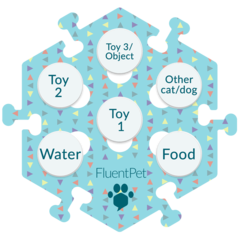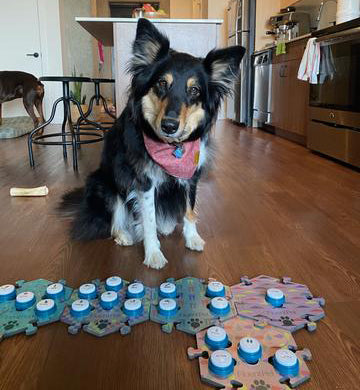What is the science behind the FluentPet system?
We've known for millennia that our dogs and other animals can understand the words we say. With FluentPet customizable talking buttons and specially designed tiles to hold and organize buttons by word category, they can say words too.
The FluentPet System combines ideas from speech language pathology and cognitive science to design arrangements that help you and your dog (or other 'learner', as we call them) communicate and remember word locations.
While it is still too early to provide scientific proof of the effectiveness of this approach, our expertise in cognitive science and years spent designing teaching tools for dogs leads us to believe that our HexTile organization method is likely to be significantly easier to remember, for any learner, than sound buttons organized in a plain square grid. By grouping buttons in categories, learners can locate buttons first more generally, and then more specifically.
HexTile Design
Background
HexTiles are not only designed to securely hold sound buttons in place, they also organize buttons by word category. A common visual pattern surrounding words of the same category makes it easier for a learner to remember which button is where, and improves the probability that your learner will be able to recognize that the words belong to a common group.
The idea of organizing words into categories for Augmentative and Alternative Communication (AAC) word boards is not a new idea. Our categories were inspired by the Fitzgerald Key, a tool developed in the early 1900s by Edith Mansford Fitzgerald. Ms. Fitzgerald was a deaf American teacher who used it to help her students construct sentences that were grammatically correct. We can’t yet be certain that the FluentPet approach to organizing button boards will be successful, but our expertise in cognitive science and years spent designing teaching tools for dogs leads us to believe that this organization is likely to be significantly easier to remember than sound buttons organized in a plain cartesian grid.
Basics
We designed the HexTiles' color patterns to be easy for learners to tell apart even if learners see colors and shapes differently. In order to be useful, the patterns must be distinguishable from each other by a learner. This means having big differences between them visually. In cognitive science, we call kinds of differences dimensions of difference. An apple might look different from another apple only in terms of its color, and nothing else, in which case we would say that it differed along only 'one' dimension (color).
For the HexTile patterns, we tried to have them be distinguishable along as many dimensions as possible, since every learner is different, and thus some will find certain differences more important than others. So, we designed the HexTiles to differ based on color, the shapes depicted within them, the size and orientation of the shapes within them, and the shapes' spacing and distribution.
Given that dogs also have limited color vision, we wanted to make sure that any colors we included could be easily distinguished irrespective of the color vision abilities of the viewer. (An approximation of dogs' color vision can be observed by using this Color Blindness Simulator and choosing "Green-Blind/Deuteranopia")
Additional Considerations
Given that we can safely assume that the patterns can be distinguished by nearly all learners, it's very likely that they will be able to learn to distinguish one tile from the other. This means one of the next things we want to avoid is the learner 'over-learning' properties of the tiles. The reason why we have varied the colors of the objects in the HexTiles is to avoid associating in a learner's mind any particular color with a word category. And for the same reason, we made sure to reuse the colors across all of the tiles. We additionally varied the tiles' background colors only slightly from one tile to the next to make it easier to see the HexTile's boundaries.
The last consideration in the HexTile’s design was that the shapes on the tiles be somehow ‘intuitive’. As a low priority, and a design consideration that’s unlikely to have any impact at all for a learner, the designs we included were not based on rigorous scientific testing (which, in any case, would have been nearly impossible to do with dogs at present). It’s unlikely that a learner, human or otherwise, would be able to immediately say what the category is that we’re associating with a given tile pattern. However, we figured we might as well try and be as intuitive as possible.
In considering the patterns themselves, we decided to group noun-related concepts (people, places, and things) and made all such word categories represented by triangles.
Subjects
The sentence ‘subjects' (people and dogs usually) are two upside-down triangles that are closer together. These somewhat look like legs or teeth, and in nature, two immediately adjacent upside-down triangular-shapes usually only happen when there are animals involved.
Objects
The sentence ‘objects’ are much smaller (things we typically call 'objects' are usually on the smaller side), and are in a range of different orientations. For example, while we usually see people right side up, we might see a dog bone in a range of different orientations.
Places
The 'places' or 'where' words are large (as places tend to be) and look like pyramids or hills.
Actions
The 'actions' or 'verbs' tile contains waves or curves, which are typically associated with motion (there are relatively very few frozen waves!). Another time that such curves occur in nature is in the arc of a thrown object.
Descriptors
The 'descriptor' words are depicted as a combination of curve and triangle. As 'modifiers', they are themselves a visual combination.
Social
The 'social' words are meant to be the most distinctive. A grid pattern such as the one it depicts is usually only found as a result of human intervention (perfect squares and rectangles are extremely rare in nature yet extremely common in the things we build).










